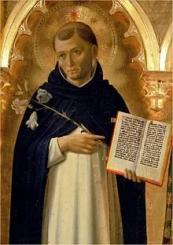|
|
Founder of the Dominicans. Saint Dominic was born at Calaruega in Castile in 1170, the youngest son of the town warden. His uncle educated him and he became an Austin Canon at Osma cathedral. In 1201, he was made sub-prior. Three years later, on his way to Denmark he met the Cathars for the first time. These were a popular sect that lived communally and had a number of extreme beliefs including the idea that the body was of no importance. |
While Simon de Monfort set about bringing them back to Christianity by brute force, sacking fine cities, burning them to the ground and slaughtering the inhabitants, Dominic dedicated himself to their reconciliation through patient and gentle argument. He didn't convert many Cathars but he saved a few lives. One day, he interceded in court on behalf of a Cathar about to be condemned to death. That young man became a Christian and later joined the Dominican order.
Three times Dominic refused a bishopric, as he believed he was called to other work. He took a leading role in the foundation of Toulouse University and then set about establishing communities of sacred learning where members could be devoted to study, teaching and preaching, as well as prayer. He retained the Divine Office but it was chanted in a simpler form.
The Dominican order rapidly spread all over Europe and became a pioneering missionary force in Asia and later the Americas. St Dominic spent his last years travelling, preaching and establishing communities and churches in Italy, Spain and France.
St Dominic died in 1221. Popular devotion to this gentle saint sprang up soon after his death. He was canonised in 1234. His tomb, at Bologna, was built 30 years later by Pisano and embellished by Michelangelo. There are many fine images of him by other artists of the time including Fra Angelico at Fiesolo and Florence.
His usual attributes in art are a lily and a black and white dog, a pun on the name of Dominic and the Dominicans (Domini canis).

